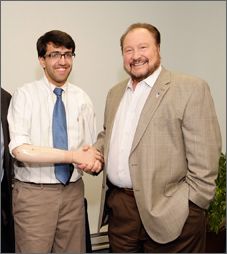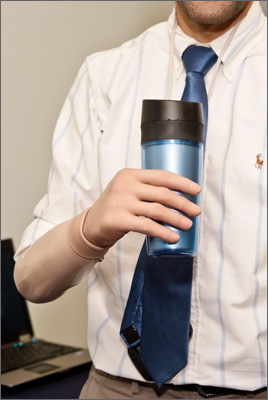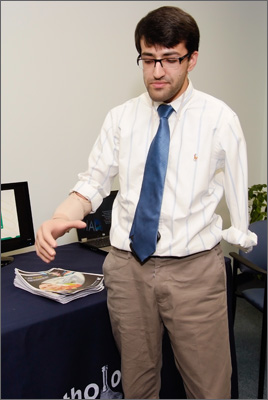
Law Student Finds New Functionality with Five-Finger Grip
 For the first time in 20 years, Angad Patheja is able to use “fingers” for assistance in daily activities thanks to the technological advancements in upper limb prosthetics from Touch Bionics, designers of the i-LIMB™ Pulse. Patheja was fitted with the i-LIMB Pulse by his Orthologix prosthetist.
For the first time in 20 years, Angad Patheja is able to use “fingers” for assistance in daily activities thanks to the technological advancements in upper limb prosthetics from Touch Bionics, designers of the i-LIMB™ Pulse. Patheja was fitted with the i-LIMB Pulse by his Orthologix prosthetist.
The i-LIMB Pulse offers the use of five fingers to bend and move, unlike previous myoelectric devices that could only open and close. These grip options support almost all daily activities, including holding a fork, picking up a coin, turning a key in a lock, operating computer keyboards, and inserting a disc into a CD or DVD player, to name just a few. The inclusion of a thumb that can, like the human thumb, be rotated into different positions enables grip configurations, many of which have not been available to amputees before.
“Angad was an excellent candidate for this technology because he had been using a myoelectric arm for most of his life,” explains his prosthetist. “However the myoelectric only provided a three-jaw chuck pattern, meaning that only the thumb and the second and third finger moved, providing him with a pinch force with limited capabilities. In contrast, the i-LIMB Pulse allows him to use multiple finger patterns such as extending the index finger for typing or using just the thumb and index finger for holding a CD.”
“With the i-LIMB, I can grip things using all five fingers. If I want to use my index finger to type or point, I am able to toggle between functions,” Patheja said. “It’s very intricate, so there are small things I can do such as holding a piece of paper without crushing it or holding a glass and taking a drink of water or holding a bar on a subway train. It’s everyday things that perhaps a person with biological hands doesn’t think of, but for me this hand will be very beneficial.”
 Patheja is currently only fitted with the i-LIMB on his right arm. Although he has a conventional prosthesis for his left arm, he wears it only infrequently because he says it is very heavy and it slows him down. He would like another i-LIMB for his left side to assist with things such as holding a paper down while he is writing and also to help keep him more balanced. “Right now, I tend to lean to the right when I’m walking because there is more weight on my right side. It’s nothing drastic, but I would like to look more normal.”
Patheja is currently only fitted with the i-LIMB on his right arm. Although he has a conventional prosthesis for his left arm, he wears it only infrequently because he says it is very heavy and it slows him down. He would like another i-LIMB for his left side to assist with things such as holding a paper down while he is writing and also to help keep him more balanced. “Right now, I tend to lean to the right when I’m walking because there is more weight on my right side. It’s nothing drastic, but I would like to look more normal.”
Patheja’s limb loss has not limited his educational or recreational pursuits. He was a high school varsity soccer player and he performed with the Bhangra Elite Dance Team at the University of North Carolina, where he graduated with a degree in philosophy and international studies. He has completed some course work for his MBA at Rutgers, but is now focused on obtaining his Juris Doctor degree from Temple’s Beasley School of Law.
Patheja became an amputee when he was two years old, the victim of a freak accident. He was standing on a balcony at the family residence in Mumbai, India, when the balcony a level above him suddenly collapsed, crushing him. He was rushed to a hospital where his right arm was amputated just below his elbow and his left arm was amputated just below his shoulder.
After his recovery, the Patheja’s moved to the Philadelphia area, and he began receiving treatment at Shriners Hospital, where the family became acquainted with Orthologix.
“Angad spent much of his early childhood in hospitals with many surgeries,” his prosthetist said. “He presents with a right, below-elbow and a left, above-elbow amputation. Due to his very short residual limb on the left side, he abandoned use of a prosthesis for most of his early childhood and relied on use of a right below elbow prosthesis.”
Once Patheja turned 21, he was no longer eligible to receive treatment from Shriners, so he turned his care over to Swoyer, who evaluated him for the i-LIMB.
 “Angad has used a myoelectric prosthesis for at least the past 15 years, so he was a perfect candidate for the upgrade,” his prosthetist said. “There was no time spent in teaching Angad how to operate a myoelectric prosthesis because of his past/present experience in operating one since a young child. Angad can hold a key and turn it to unlock a door. He can insert a CD into a computer, type with one finger on computer keyboard, MAC Machine and/or cell phone. He can hold larger objects (cups/bottles). He can increase his grasp strength. The hand looks and moves like a real hand, and its covering also makes it look natural. That helps with any amputee’s self-esteem.”
“Angad has used a myoelectric prosthesis for at least the past 15 years, so he was a perfect candidate for the upgrade,” his prosthetist said. “There was no time spent in teaching Angad how to operate a myoelectric prosthesis because of his past/present experience in operating one since a young child. Angad can hold a key and turn it to unlock a door. He can insert a CD into a computer, type with one finger on computer keyboard, MAC Machine and/or cell phone. He can hold larger objects (cups/bottles). He can increase his grasp strength. The hand looks and moves like a real hand, and its covering also makes it look natural. That helps with any amputee’s self-esteem.”
Although Patheja is well-versed in myoelectric technologies, he still faced a learning curve when using the high-tech i-LIMB. “Before I had basic open and close functions, but now there are so many different, but useful, functions on it that it is taking me a little time to get used to it. But it gets better every day,” he said.
His prosthetist concurs: “The learning curve came for the both of us in programming the desired grip patterns that he wanted to use,” said Swoyer. “This was and is an ongoing process since Angad has started law school and isn’t able to spend much time at the office. I feel it safe to say that Angad figures things out on his own and has worked on changing patterns independently. Once he gets some free time, we will get together for a follow-up visit, and my education will continue with Angad as the teacher.
“Angad is an amazing individual who has overcome so many obstacles that able-bodied people take for granted. It has been a privilege working with him. Our next adventure, once time permits, is to provide a left, above-elbow prosthesis.”
i-LIMB contraindications
For any myoelectric prosthesis, the patient has to have adequate electrical signals from movement of their muscles. A new candidate would be tested for strength of their electrical signal given off from movement of their muscles. In addition, standard guidelines apply, meaning that a patient’s residual limb must be viable to accept fitting of a prosthetic socket. This would include adequate length of residual limb as well as overall skin condition (well healed/well shaped/skin grafts).


For more information on our orthotic or prosthetic services, contact us: ORTHOLOGIX® // 2655 Interplex Drive, Suite 101 // Trevose, PA 19053 // Phone: (800) 659-9755
